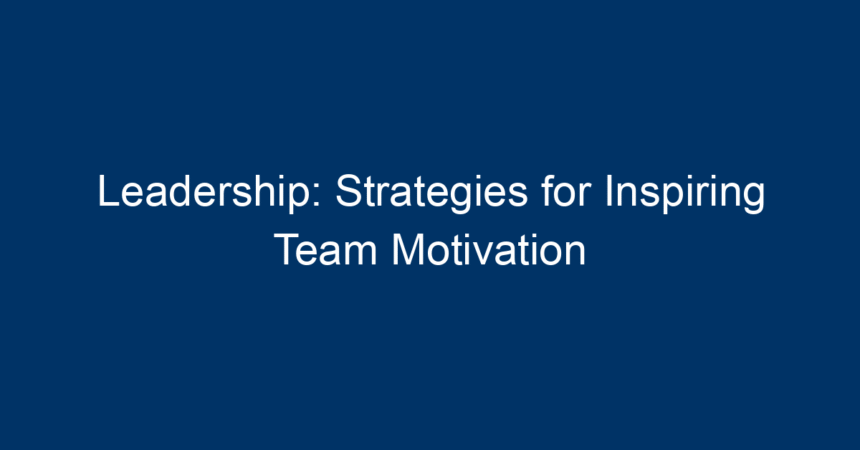In today’s fast-paced corporate landscape, effective leadership is more crucial than ever. The ability to inspire team motivation can significantly impact productivity, employee engagement, and overall organizational success. When individuals feel motivated, they are more likely to contribute positively to team objectives. This article delves into practical strategies that leaders can utilize to foster an environment of motivation, collaboration, and innovation.
Understanding Leadership and Team Motivation
The Role of Leadership
Leadership is not merely about a title; it’s an art and science that encompasses vision, influence, and the ability to inspire others. Effective leadership involves understanding team dynamics, recognizing individual strengths, and fostering an environment of trust and collaboration. The results of strong leadership are reflected in the team’s motivation levels, job satisfaction, and performance.
The Importance of Team Motivation
Team motivation is the driving force behind employee engagement and productivity. When team members are motivated, they are more likely to take initiative and contribute to a positive workplace culture. A motivated team is also better equipped to handle challenges, leading to improved problem-solving and creativity. In contrast, lack of motivation can result in higher turnover rates, lower productivity, and a toxic work environment.
Key Strategies for Inspiring Team Motivation
1. Communicate a Clear Vision
One of the foundational elements of effective leadership is communication. Leaders must articulate a clear and compelling vision that resonates with team members. This vision serves as a roadmap, guiding the team toward common goals.
Action Steps:
- Define the Vision: Clearly outline what the team is striving to achieve.
- Regular Updates: Keep team members informed about progress and any changes to the vision.
- Encourage Feedback: Involve team members in refining the vision to foster ownership and commitment.
2. Foster a Culture of Trust
Creating a trusting environment is essential for team motivation. When team members feel safe to express their ideas and concerns, they are more likely to engage fully in their work.
Action Steps:
- Open Communication: Encourage open dialogue and actively listen to team members.
- Lead by Example: Demonstrate integrity and transparency in your actions.
- Recognize Contributions: Acknowledge individual and team achievements regularly to build trust and respect.
3. Empower Your Team
Empowerment is a powerful motivational tool. When team members are given the autonomy to make decisions, they feel valued and respected.
Action Steps:
- Delegate Authority: Allow team members to take ownership of their tasks and decisions.
- Provide Resources: Ensure your team has the tools and information they need to succeed.
- Encourage Innovation: Create an environment where new ideas and approaches are welcomed.
4. Set Achievable Goals
Setting clear, achievable goals is vital for maintaining motivation. SMART (Specific, Measurable, Achievable, Relevant, Time-bound) goals can guide teams toward success while keeping them focused.
Action Steps:
- Collaborative Goal Setting: Involve the team in the goal-setting process to enhance buy-in and commitment.
- Monitor Progress: Regularly check in on progress, celebrating achievements and addressing challenges.
- Adjust as Necessary: Be flexible and willing to adjust goals based on feedback and changing circumstances.
5. Provide Professional Development Opportunities
Investing in your team’s professional growth is a key strategy for enhancing motivation. When employees see that their leader cares about their career advancement, they are likely to feel more motivated to perform.
Action Steps:
- Training Programs: Offer workshops, courses, or seminars relevant to your team’s roles.
- Mentorship Opportunities: Pair team members with mentors who can offer guidance and support.
- Career Pathing: Help employees identify potential career paths within the organization.
6. Foster a Positive Work Environment
A supportive and positive work environment can significantly impact team motivation. Creativity and collaboration flourish in workplaces where employees feel comfortable and valued.
Action Steps:
- Encourage Collaboration: Promote teamwork and create opportunities for team-building activities.
- Recognize Work-Life Balance: Support flexible working arrangements that allow team members to maintain a healthy balance.
- Celebrate Milestones: Take the time to celebrate both personal and professional milestones within the team.
7. Utilize Recognition and Reward Systems
Recognition and rewards are powerful motivators. Genuine acknowledgment of a team member’s hard work can boost morale and inspire continued effort.
Action Steps:
- Establish Recognition Programs: Create formal recognition programs that celebrate achievements, both big and small.
- Personalized Rewards: Understand what motivates each team member; consider personalized rewards that resonate with them.
- Regular Recognition: Make recognition a regular part of your leadership style, not just a once-a-year event.
8. Lead with Empathy
Empathy is a critical leadership skill that fosters a strong connection between leaders and their teams. Understanding the personal and professional challenges your team may face can enhance motivation and loyalty.
Action Steps:
- Listen Actively: Show genuine interest in team members’ thoughts and feelings.
- Be Approachable: Create a culture where team members feel comfortable discussing challenges.
- Offer Support: Provide the necessary support and resources to help team members overcome obstacles.
Conclusion: Taking Action Towards Effective Leadership
Effective leadership is a continuous journey of growth and adaptation. By employing these strategies to inspire team motivation, leaders can create a thriving environment where employees feel valued and engaged.
Actionable Insights:
- Regularly assess your leadership style and be open to feedback on areas for improvement.
- Continuously invest in your team’s growth through training and professional development opportunities.
- Foster open communication and create a safe space for team members to share their ideas and concerns.
By consciously implementing these strategies, any leader can inspire their team, resulting in a motivated workforce that drives positive outcomes for the organization. Remember, motivated teams are not only more productive; they are also happier, leading to greater organizational resilience and success.




